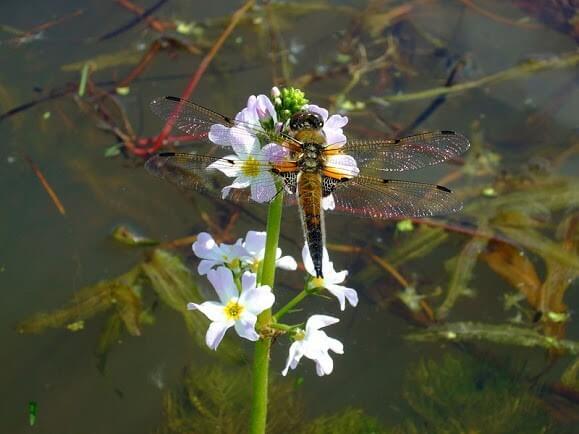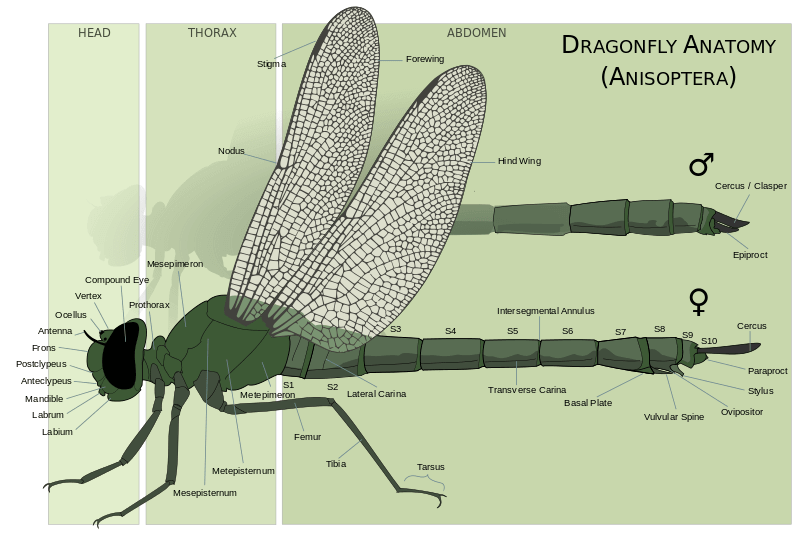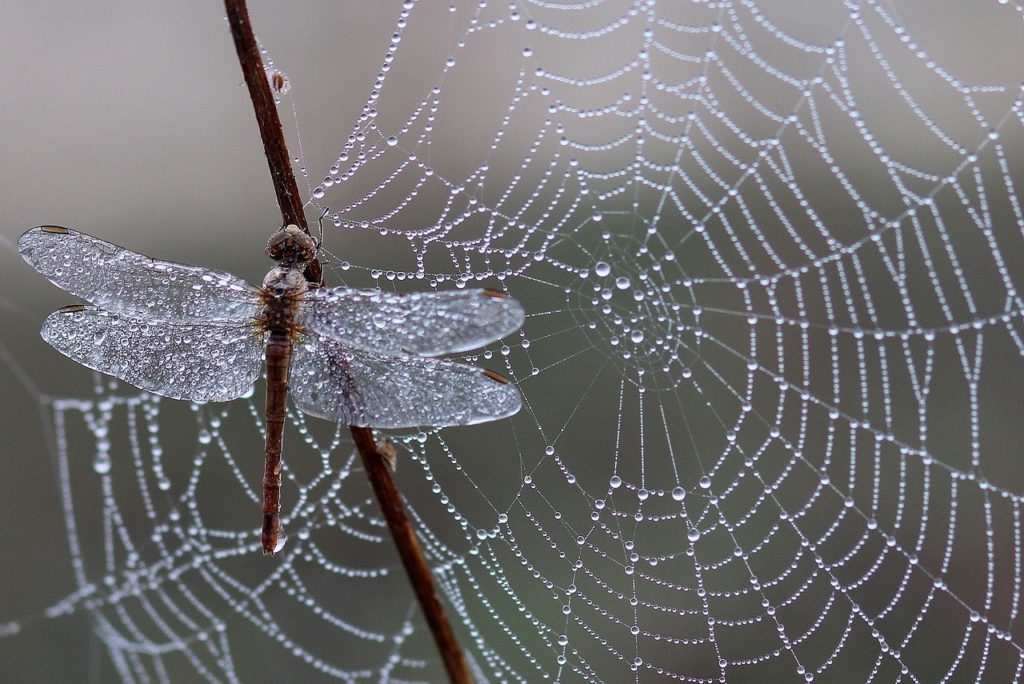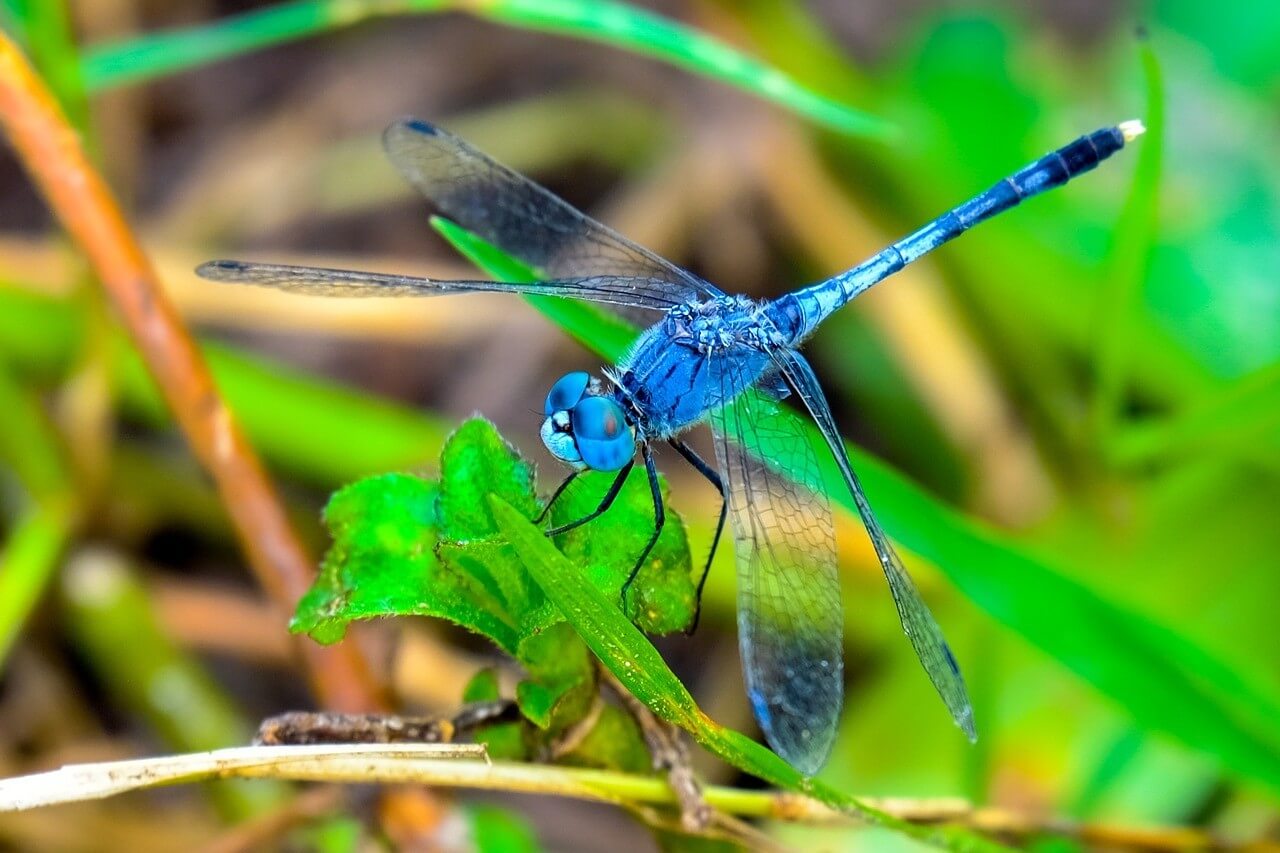Dragonflies: The Pretty Drones of Nature
Who wouldn’t have noticed that beautiful creature with large body, transparent wings and large eyes, flying and hovering around plants and ponds? Adults name them as dragonflies, but children love to call them “airplanes” and indeed, they do represent some very refined and intelligent aircraft engineering by Mother Nature. The flight of the dragonfly is so special that it has inspired engineers who dream of making robots that fly like dragonflies.
Their Family History
Taxonomically, dragonflies belong to the order Odonata (meaning “toothed ones.”). That is why, watching dragonflies, similar to bird watching, is called oding.
Dragonflies can be mistaken for the related group, damselflies (Zygoptera), which are similar in structure, though usually lighter in build; however, the wings of most dragonflies are held flat and away from the body, while damselflies hold the wings folded at rest, along or above the abdomen.
They have been around for 300 million years.
“Dragonflies are one of the oldest insects,” says an entomologist at Chicago’s Field Museum: “There are fossil records that date back to pre-dinosaur times.”
Prehistoric dragonflies were much larger and could have a wingspan of 2 ½ feet!
By the way, they are not really related to common flies.
Where Do They Live?
Dragonflies are born in water and love to live around ponds and rivers. Some of their species prefer running water while others prefer standing water. . Adult dragonflies require waterside plants to use as perches; some of them may need specific floating plants on which to lay eggs.

Dragonflies are capable of tolerating seasonal changes in water level and temperature of ponds and pools.
They need to warm up in the sun during the morning before taking off and flying for most of the day.
Physical and Biological Characteristics
Dragonfly are characterized by long bodies with two narrow pairs of intricately veined, membranous wings that, while generally transparent, may have colored markings. Unlike damselflies, the front and rear wing pairs are shaped differently. In addition, dragonflies rest with their wings spread horizontally, rather than held vertically against each other. Dragonflies have a more powerful build and are generally much stronger fliers than damselflies. The globe skimmer or wandering glider, a migratory dragonfly, for example, makes an annual multi generational journey of some 18,000 km (about 11,200 miles); to complete the migration, individual globe skimmers fly more than 6,000 km (3,730 miles)—one of the farthest known migrations of all insect species.

- · A dragonfly’s head is all eyes! Dragonflies have huge bulging eyes that occupy most of the head, giving some a field of vision approaching 360 degrees.
- · Dragonflies are actually carnivorous. They have strong jaws with sharp teeth that they use for catching and eating, and primarily eat other bugs. Their diet consists of smaller bugs like mosquitos, moths, and butterflies.
- · Dragonflies are some of the most colorful insects on the planet. They come in a variety of colors including blue, green, yellow, and red. They also come in a range of sizes from half an inch long to over 5 inches long.
- · As insects, dragonflies have 6 legs, a thorax, a head, and an abdomen. The abdomen is long and segmented. Despite having 6 legs, the dragonfly doesn’t walk very well.
- · When first hatched, the larva or nymphs live in the water for around a year. Once they leave the water and begin to fly, they only live for around a month.
- · The winged adults are diversely colored in a variety of shades ranging from metallic to pastel. Compared with other insects, they are large, with some having wingspans of up to 16 cm (about 6 inches). Even the smallest species are about 20 mm (0.8 inch) across.
- · The life cycle of a dragonfly is Egg (usually laid under water), Larva (free moving, water dwelling nymph) and Adult.
- · The larva lives for several weeks (or years depending on species) underwater and undergoes a series of moults as it grows. It emerges from the water when it is ready to undergo its final moult where the “skin” splits to release the winged adult; much as a Butterfly or Moth emerges from its pupa.
- · Young dragonflies, called larvae or sometimes nymphs or naiads, are aquatic and are as dedicated predators under water as the adults are in the air.
- · When dragonflies first emerge from their water-borne larval stage, most have very muted colors. Depending on weather conditions, it can take a few days for them to gain their bright adult color.
- · At the end of its larval stage, the dragonfly crawls out of the water, then its exoskeleton cracks open and releases the insect’s abdomen, which had been packed in like a telescope. Its four wings come out, and they dry and harden over the next several hours to days.
- · Dragonflies, like damselflies, exhibit a mating posture unique to the Odonata. The male and female contort themselves into the “wheel” position before sperm is transferred. Before and after mating, dragonflies often fly in tandem, with the male towing the female in flight using claspers at the tip of his abdomen to grip the back of her head. Pairs of some species may remain in tandem while the female lays her eggs.
- · Some adult dragonflies live for only a few weeks while others live up to a year. The adults live just long enough to mature and reproduce and will not live beyond several months, depending on the quality of the weather and weather conditions. They may live longer when the weather is dry and warm. However, in the short and sometimes cold weather, adults will not live for longer than several weeks.
- · Some dragonflies are colored black and yellow, or black and red, which is the universal warning coloration and may deter some of the bird predators.
- · Dragonflies have a pair of antennae. They are very tiny and difficult to see. As dragonflies rely much more on their eyesight than on a sense of touch or smell, they do not need the large antennae found on some beetles and moths.
Social Behavior
*Dragonflies don’t sting and generally don’t bite people.
*Hundreds of dragonflies of different species will gather in swarms, either for feeding or migration. Little is known about this behavior, but the Dragonfly Swarm Project is collecting reports on swarms to better understand the behavior. (https://www.scientificamerican.com/citizen-science/the-dragonfly-swarm-project)
* Dragonflies also have their enemies. Among the species that catch and eat adult dragonflies and damselflies are birds, Spiders (many dragonflies are caught in webs), Frogs, and larger species of dragonflies (which catch and eat other dragonflies and damselflies). In the larval stage, which is spent underwater, they are preyed on by fish, frogs, toads and newts, other water invertebrates – and Kingfishers.
* Certain species of dragonfly migrate, either in group or individually. They follow weather fronts, fleeing cold fronts in the fall on their way south and chasing warm fronts in the spring when moving north.
* Dragonflies, especially the males, are known to be highly territorial, and even more so during breeding season, when females have to mate with them in order to lay eggs in their territory. They usually stay nearby, defending their territory from other dragonflies or sometimes, other insects.
* Dragonflies need protection from the dangers humans have created, from pollution to habitat loss. Thankfully, there are sanctuaries around the world.
Their Strengths As Aerial Predators
- Dragonflies are magnificent aerialists, able to hover like a helicopter, dive, fly backward and upside down, pivot 360 degrees with three tiny wing beats, and reach speeds of 30 miles per hour, lightning for an arthropod.
- Dragonflies are true visionaries. Their eyes are the largest and possibly the keenest in the insect world, a pair of giant spheres each built of some 30,000 pixel-like facets that together take up pretty much the entire head.
- They have a full field of vision, they can see you when they’re flying toward you and still see you when they’re flying away.
- The nervous system of a dragonfly displays an almost human capacity for selective attention, able to focus on a single prey as it flies amid a cloud of similarly fluttering insects, just as a guest at a party can attend to a friend’s words while ignoring the background chatter.
- Dragonflies can intercept their prey in midair. They don’t simply chase down their prey. Instead, they snag them from the air with calculated aerial ambushes. Dragonflies can judge the speed and trajectory of a prey target and adjust their flight to intercept prey. They’re so skilled they have up to a 95% success rate when hunting. Basically, think “stealth fighter jet” when it comes to a dragonfly’s ability to nab prey in flight quickly, effectively, and intelligently. Their hunting strategy is impressive, but dragonflies’ ability to rip apart prey takes their predatory prowess to another level. When hunting, dragonflies catch prey with their feet, tear off the prey’s wings with their sharp jaws so it can’t escape, and scarf the sorry bug down, all without needing to land.
Dragonflies Are Human-Friendly Insects
The dragonflies do an amazing job of helping humans by controlling populations of pest insects, especially those that bug us most, such as mosquitoes and biting flies. A single dragonfly can reportedly eat anywhere from 30 to hundreds of mosquitoes per day.
They help us understand the health of ecosystems and appear to be an indicator of water quality, habitat quality and climate change.

They also inspire us to create new technology — from drones to artificial visual systems — based on their incredible skills at flight and vision. The least we humans can do to return the favor is support the conservation of their habitats so they can continue on for another 300 million years.
They Need Protection
Dragonflies are in danger of extinction!

Fifty years ago there were twice as many ponds in developed countries as there are today. The draining of agricultural land, filling in and pollution have all contributed to the disappearance of most countryside ponds. Canals have also suffered from pollution, especially by chemicals used on farmland draining into water. The loss of suitable fresh water habitats has affected dragonflies enormously and they are becoming increasingly rare.
Garden ponds have become very popular over recent years and these are helping to save Human threatened pond-life including dragonflies. Creating a pond habitat in your garden at home, or in your school grounds, is a practical and worthwhile conservation project.
**************

